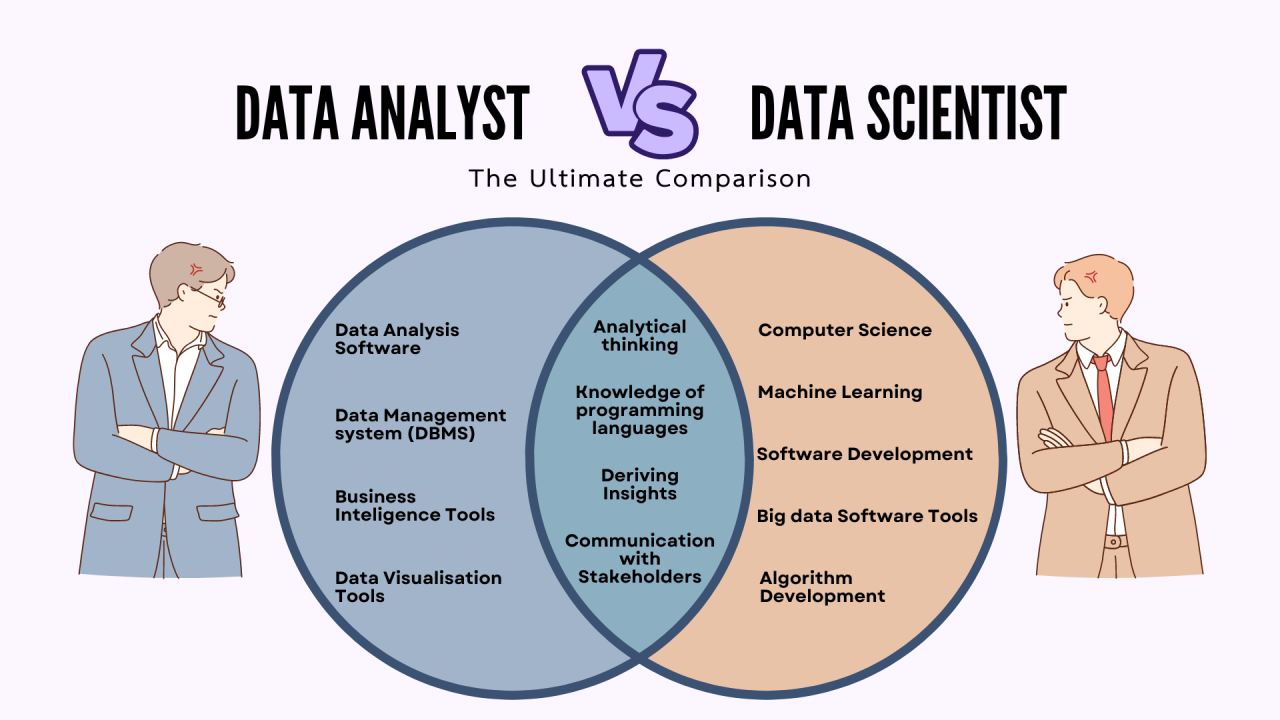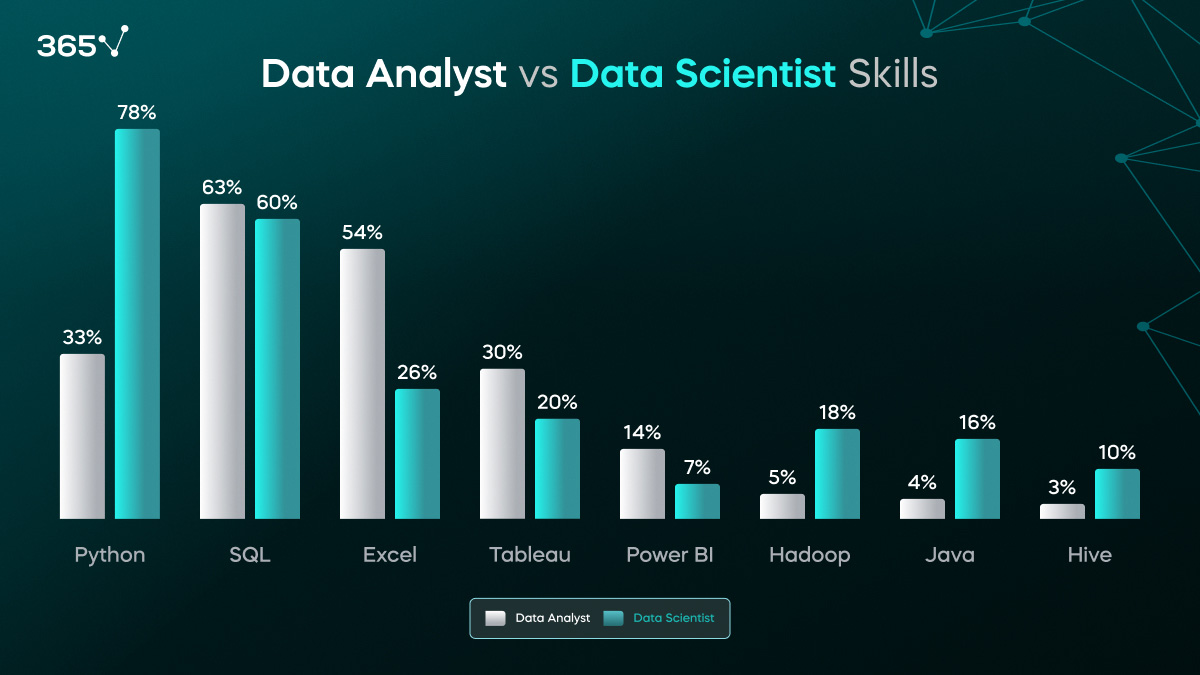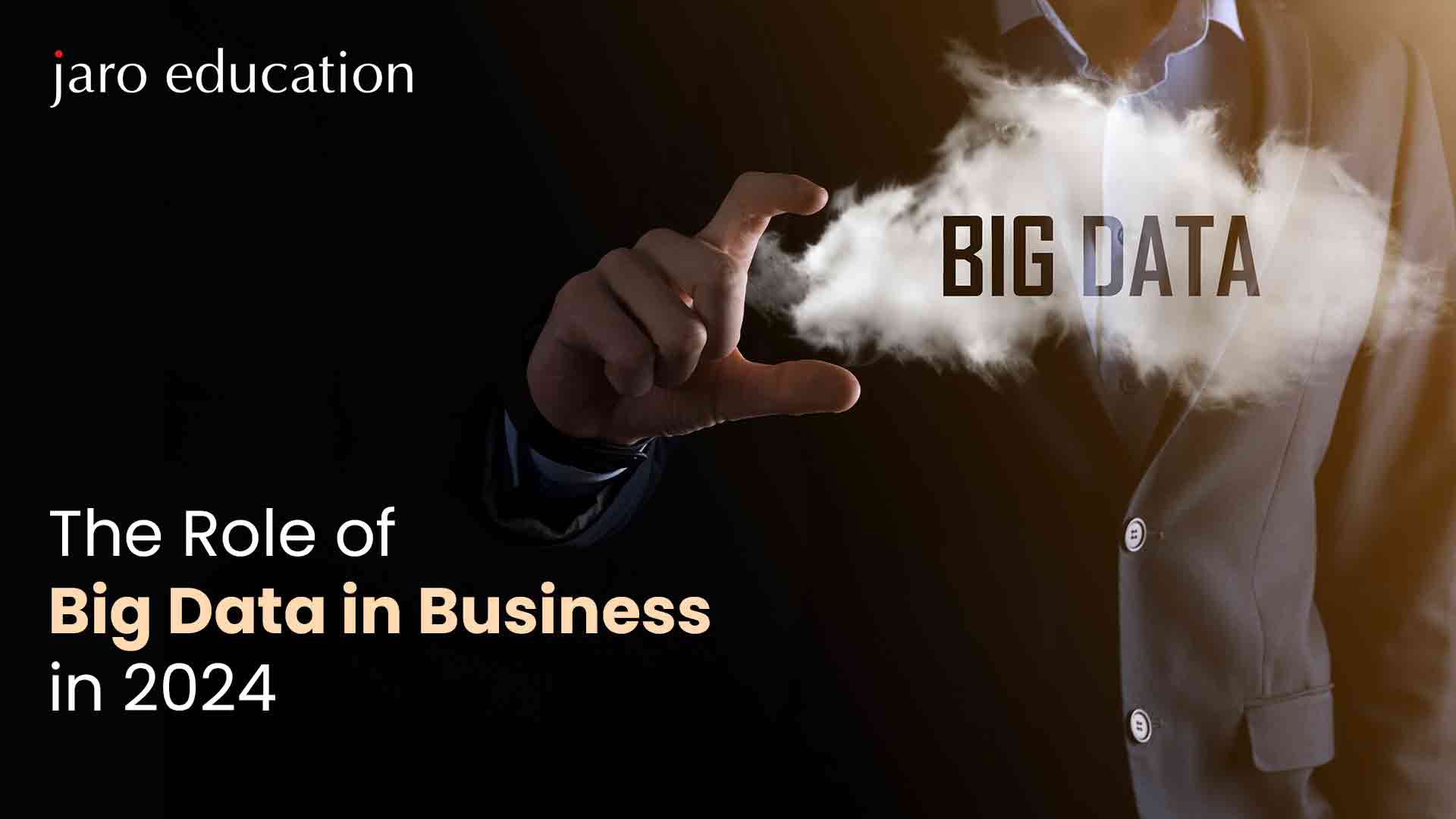The Truth About the Difference Between Data Analyst and Data Scientist
Table of Contents

- jaro education
- 15, November 2024
- 4:00 pm
As the world becomes more data-driven, the roles of data scientists and data analysts are in the spotlight, each contributing unique skills to shape data insights and drive informed decisions. While the two positions may seem similar at first glance, they differ in scope, approach, and skill requirements. This blog will unravel the difference between a data analyst and a data scientist, helping you understand which career might suit you best. If you’re eyeing a path in data or looking to advance your skills, this guide will walk you through the core distinctions between data scientists and data analysts.
Understanding the difference between a data analyst and a data scientist is crucial in deciding which role suits your skills and career aspirations. Both positions work with data, but their day-to-day tasks, tools, and outcomes differ significantly. In this blog, we’ll explore these differences between a data analyst and a data scientist to help you decide the right career for you, whether you’re wondering how to become a data scientist or looking into the career prospects of a data analyst.
1. Data Scientist vs. Data Analyst: Role Comparison
| Aspect | Data Scientist | Data Analyst |
|---|---|---|
| Role Summary | Builds predictive models, explores trends in large datasets | Analyzes data for actionable insights in specific business areas |
| Primary Focus | Data modeling, machine learning, advanced analytics | Descriptive and diagnostic analytics |
| Key Tools Used | Python, R, SQL, TensorFlow, Hadoop | Excel, SQL, Tableau, Power BI |
| Goal | Predict future trends and guide strategic decisions | Summarize and visualize data to solve business questions |
| Career Path | Often includes a Master’s or PhD in data science-related fields | Often requires a Bachelor’s in a data-related field |
| Complexity of Skills | High – requires strong programming, statistics, and machine learning | Medium – requires proficiency in data analysis and visualization |

*DataScienceDojo
The difference between a data analyst and a data scientist is primarily rooted in the level of complexity involved. Data scientists typically engage in deep predictive modeling, statistical analysis, and machine learning, while data analysts focus on summarizing data, producing reports, and offering immediate, actionable insights. If you’re curious about how to become a data scientist, it usually involves advanced education in math, programming, and statistics. Data analyst jobs, however, often require a bachelor’s degree and more practical, hands-on experience with data visualization and reporting tools.
2. Skill Set Breakdown
| Skill Area | Data Scientist | Data Analyst |
|---|---|---|
| Statistical Knowledge | Advanced – includes probability, inferential statistics, and more | Intermediate – focuses on descriptive statistics |
| Programming Languages | Python, R, SQL | SQL, Excel, VBA, Python (occasionally) |
| Machine Learning | High – core part of the role | Low – not typically a primary requirement |
| Data Wrangling | Advanced – handling complex data structures, big data sources | Intermediate – cleaning and structuring data for analysis |
| Data Visualization | Intermediate – often uses Python libraries like Matplotlib, Seaborn | Advanced – uses BI tools like Tableau, Power BI |
| Business Acumen | Essential for model-building relevant to business goals | Essential for meaningful analysis and insights |

*LinkedIn
The difference between a data analyst and a data scientist also lies in the skillset. Data scientists are expected to have advanced knowledge in machine learning and big data tools. In contrast, data analysts need to master data visualization, reporting, and descriptive analytics. If you’re wondering about the data scientist course fee, it tends to be higher due to the specialized content and advanced technologies involved in the curriculum. A free data analyst course might be available online for those starting in the field, especially for foundational courses.
3. Core Responsibilities
| Responsibility | Data Scientist | Data Analyst |
|---|---|---|
| Data Collection | Extracts and integrates data from diverse sources | Collects data primarily from databases and spreadsheets |
| Exploratory Data Analysis | Extensive – explores complex datasets to find patterns | Focused – often follows a predefined approach |
| Data Modeling | Develops predictive models and tests them | Rarely involves modeling – primarily focuses on analysis |
| Reporting | Produces advanced reports, forecasts, and insights | Creates regular reports and dashboards for business stakeholders |
| Insight Delivery | Focused on strategic insights and long-term impact | Focused on immediate, actionable insights |
The difference between a data analyst and a data scientist becomes evident in the responsibility areas. A data scientist builds models that predict future trends, while data analysts summarize current data to solve specific business problems. If you’re considering how to become a data scientist, the role often requires expertise in machine learning and a deeper understanding of statistical modeling. On the other hand, data analyst jobs typically focus more on creating reports and dashboards that are directly used by business teams.
4. Educational Path and Experience
| Factor | Data Scientist | Data Analyst |
|---|---|---|
| Educational Requirement | Master’s or PhD preferred (in Statistics, Data Science, or ML) | Bachelor’s (in Business, Economics, or related fields) |
| Preferred Certifications | Data Science, Machine Learning, AI | Data Analysis, Business Analytics, BI tools |
| Typical Experience Level | 3–5 years in analytical roles before entry | 1–3 years in business analysis or entry-level positions |
The difference between a data analyst and a data scientist also extends to the educational path. Data scientists often need advanced degrees, while a data analyst can enter the field with a bachelor’s degree. If you’re wondering how to become a data scientist, it’s important to focus on advanced coursework in statistics and machine learning. Many individuals are also interested in the data scientist course fee, which can vary but is typically higher due to the specialized nature of the courses. For those on a budget, there are options like free data analyst courses that provide foundational knowledge.
5. Career Progression and Salaries
| Aspect | Data Scientist | Data Analyst |
|---|---|---|
| Entry-Level Salary | High (starting around ₹6 – ₹8 lakh per year) | Moderate (starting around ₹4 – ₹5 lakh per year) |
| Mid-Level Salary | ₹10 – ₹12 lakh per year | ₹6 – ₹7 lakh per year |
| Growth Opportunities | Chief Data Scientist, Machine Learning Engineer, Data Architect | Senior Data Analyst, Business Intelligence Analyst |
The difference between a data analyst and a data scientist is most evident when looking at salaries. Data scientists generally command higher salaries, with entry-level salaries starting at ₹6 – ₹8 lakh per year in India, whereas a data analyst salary typically starts at ₹4 – ₹5 lakh per year. This is because data scientists are expected to have a deeper skill set involving machine learning and statistical modeling, which can be demanding. For those interested in pursuing this path, understanding the data scientist salary in India can help set expectations, but salaries vary based on experience and industry.
6. Key Tools Used by Data Scientists and Data Analysts
| Tool Category | Data Scientist | Data Analyst |
|---|---|---|
| Programming Languages | Python, R | SQL, VBA, occasionally Python |
| Data Visualization | Matplotlib, Seaborn, ggplot | Tableau, Power BI |
| Machine Learning Libraries | TensorFlow, PyTorch, Scikit-Learn | Not typically used |
| Big Data Tools | Hadoop, Apache Spark | Not typically required |

*365datascience.com
Data scientists use more advanced tools, especially when it comes to machine learning and big data processing. How to become a data scientist often involves getting hands-on experience with tools like TensorFlow or Apache Spark. If you are more focused on business reporting, data analyst jobs will likely have you using tools like Tableau and Power BI.
7. Which Role Is Right for You?
-
- Enjoy programming, math, and statistics, and are excited about building predictive models.
- Are comfortable with advanced technical tools and concepts like machine learning, big data, and cloud computing.
- Seek a role where you can influence strategic business decisions with complex insights.
-
- Have a knack for transforming data into business insights through analysis and visualization.
- Prefer working with data in a structured, report-driven way without deep programming requirements.
- Want a more immediate impact on business processes by analyzing data trends.
Conclusion: Which Career Path Is Right for You?
In conclusion, the difference between a data analyst and a data scientist is stark, with data scientists taking on a more technical and predictive role, while data analysts focus on transforming data into actionable business insights. If you’re intrigued by how to become a data scientist, pursuing an advanced course in data science or machine learning can be an excellent way to gain the necessary skills.
Whether you are more interested in the broad analytical approaches of a data analyst or the technical complexities of a data scientist, pursuing formal education can make a huge difference. Jaro Education offers specialized courses that cater to aspiring data professionals. Whether you’re looking to advance your career or start from scratch, Jaro’s data scientist courses’ fees are affordable, and their curriculum covers everything from foundational analytics to advanced machine learning.
Explore the opportunities that Jaro Education offers in data science and analytics courses to give your career the boost it needs. Whether you’re interested in data analyst salary or planning your next career move, Jaro’s guidance can help you achieve your goals.
Frequently Asked Questions
- The answer to which is better — data science or data analyst — really depends on your career aspirations and interests. If you enjoy working with big data, predictive models, and machine learning, then data science is a more exciting and complex field, making it a good choice for those who like a challenge. In contrast, if you prefer working with structured data and providing immediate business insights through visualizations and reports, a data analyst role might suit you better.
- To understand the difference between a data analyst and a data scientist, consider the skill sets required. A data scientist needs advanced skills in programming, statistical modeling, and machine learning, while a data analyst focuses more on data interpretation and business problem-solving. So, the difference between a data analyst and a data scientist lies in the level of technical knowledge and the types of projects handled.
- Ultimately, data science might offer more opportunities for career growth, higher salaries, and more technical challenges, but data analyst roles are equally important, and often more accessible to those with a business focus. When choosing between the two, think about your long-term goals and the difference between a data analyst and a data scientist in terms of both job satisfaction and compensation.
- Yes, a data scientist can transition into a data analyst role. While the difference between a data analyst and a data scientist involves the complexity and scope of work, both roles share common tools like SQL, Excel, and Tableau. A data scientist may need to adjust their focus from complex predictive models and machine learning algorithms to more descriptive and diagnostic analytics. Since data scientists often have strong foundations in data processing and analysis, this transition is entirely possible.
- However, it’s important to note that the difference between a data analyst and a data scientist could mean that a data scientist may find the data analyst role less technically demanding, focusing more on reporting and business analysis. If you are already a data scientist and are considering transitioning into a data analyst role, you might find the work more structured and with a shorter learning curve when compared to the advanced machine learning techniques used in data science.
- advanced skill set and the complexity of their roles. The difference between a data analyst and a data scientist in terms of salary is significant, with data scientists generally commanding higher salaries due to their expertise in machine learning, statistics, and advanced data modeling.
- However, in certain cases, a data analyst with significant experience and expertise in specialized business areas, such as business intelligence, or those who work in high-demand industries, might earn a comparable salary to an entry-level data scientist. But in general, the data scientist salary is higher, reflecting the more technical nature of the role.
- When considering salaries, it’s also essential to factor in the difference between a data analyst and a data scientist in terms of career progression. A data scientist has more room for advancement into roles such as chief data scientist or machine learning engineer, which can significantly increase earnings over time.
- In terms of job hierarchy and compensation, a data scientist is typically considered above a data analyst. The difference between a data analyst and a data scientist in terms of skills, job complexity, and responsibilities places the data scientist in a more advanced position within most organizations. Data scientists often have a higher level of technical knowledge and are responsible for building predictive models, working with complex datasets, and utilizing machine learning algorithms.
- On the other hand, data analysts are primarily focused on analyzing and interpreting data to generate insights and reports, which makes their role slightly less technical compared to data scientists. While both roles are crucial to any data-driven organization, the difference between a data analyst and a data scientist in terms of technical depth and job scope means that a data scientist typically holds a more senior role, both in terms of career trajectory and salary.









